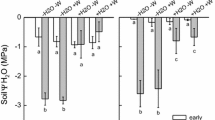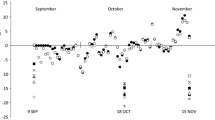Abstract
Alpine herbaceous plants employ two mechanisms to prevent freezing injury to leaves during the growing season, i.e., they avoid freezing by transient supercooling or tolerate the occurrence of extracellular ice. I examined seasonal changes in the two freezing resistance mechanisms in leaves of alpine plants from two temperate mountain regions, Niwot Ridge (3500 m) in the Front Range of the Rocky Mts. (USA) and Modré sedlo (1510 m) in the Giant Mts. (Czech Republic). Although plants from Niwot Ridge were on average ca. 2.6 K more resistant to freezing than plants from the Giant Mts., patterns of freezing resistance changes during the growing season were consistent between the two regions. Both freezing resistance mechanisms, i.e., avoidance by supercooling and tolerance of extracellular ice were encountered. Plants predominantly avoided freezing injury during early summer and tolerated extracellular freezing at the end of the growing season, and the seasonal change from avoidance to tolerance mechanisms was significant for both regions. The avoidance and tolerance mechanisms provided comparable freezing resistance to the plants during early summer but, unlike in avoidant plants, in tolerant plants resistance increased over the course of the season. The species formed three groups with regard to resistance mechanisms employed during the season: (1) species that avoided injury by supercooling during early summer and employed freezing tolerance towards autumn; (2) species that were freezing tolerant during the entire growing season; and (3) species with ephemeral shoots that solely avoided freezing by supercooling. Although freezing tolerance is a common feature in north-temperate alpine plants, avoidance by supercooling as a freezing resistance strategy might be selected for in species with particular life histories such as ephemeral hemiparasites.


Similar content being viewed by others
References
Agrawal AA, Conner JK, Stinchcombe JR (2004) Evolution of plant resistance and tolerance to frost damage. Ecol Lett 7:1199–1208
Araújo M, Ferri-Yáñez F, Bozinovic F, Marquet PA, Valladares F, Chown SL (2013) Heat freezes niche evolution. Ecol Lett 16:1206–1219
Beck E (1994) Cold tolerance in tropical alpine plants. In: Rundel PW, Smith AP, Meinzer FC (eds) Tropical alpine environments. Plant form and function. Cambridge University Press, Cambridge, pp 77–110
Bowmann WD, Seastedt TR (eds) (2001) Structure and function of an alpine ecosystem. Oxford University Press, Oxford
Briceño VF, Harris-Pascal D, Nicotra AB, Williams E, Ball MC (2014) Variation in snow cover drives differences in frost resistance in seedlings of the alpine herb Aciphylla glacialis. Environm Exp Bot 106:174–181
Cronquist A, Holmgren AH, Holmgren NH, Reveal JL, Holmgren PK (1984) Intermountain flora: vascular plants of the intermountain west, USA. Subclass Asteridae (except Asteraceae), vol 4. NYBG Press, New York
Cronquist A, Holmgren NH, Holmgren PK (1997) Intermountain flora: vascular plants of the intermountain west, USA, part A: Subclass Rosidae (except Fabales), vol 3. NYBG Press, New York
Daněk M, Sklenář P, Kučerová A (2016) Seasonal changes of freezing resistance in ericoid peat-bog shrubs from two populations in the Czech Republic. Silva Gabreta (accepted)
Flora of North America Editorial Committee (1993) Flora of North America North of Mexico, vol 18. Oxford University Press, New York
Goldstein G, Rada F, Azocar A (1985) Cold hardiness and supercooling along an altitudinal gradient in Andean rosette species. Oecologia 68:147–152
Greenland D, Losleben M (2001) Climate. In: Bowman WD, Seastedt TR (eds) Structure and function of an alpine ecosystem. Oxford University Press, Oxford, pp 15–31
Guy CL (2003) Freezing tolerance of plants: current understanding and selected emerging concepts. Canad J Bot 81:1216–1223
Hacker J, Ladinig U, Wagner J, Neuner G (2014) Inflorescences of alpine cushion plants freeze autonomously and may survive subzero temperatures by supercooling. Plant Sci 180:149–156
Jackson LE, Bliss LC (1984) Phenology and water relations of three plant life forms in a dry tree-line meadow. Ecology 65:1302–1314
Janáček J, Prášil I (1991) Quantification of plant frost injury by nonlinear fitting of an S-shaped function. Cryoletters 12:47–52
Jordan DN, Smith WK (1995) Microclimate factors influencing the frequency and duration of growth season frost for subalpine plants. Agric For Meteorol 77:17–30
Karlson DT, Xiang Q-Y, Stirm VE, Shirazi AM, Ashworth AN (2004) Phylogenetic analyses in Cornus substantiate ancestry of xylem supecooling freezing behavior and reveal lineage of desiccation related proteins. Plant Physiol 135:1654–1656
Kishimoto T, Yamazaki H, Saruwatari A, Mukarawa H, Sekozawa Y, Kuchitsu K, Price WS, Ishikawa M (2014) High ice nucleation activity located in blueberry stem bark is linked to primary freeze initiation and adaptive freezing behaviour of the bark. AoB Plants 6:plu044. doi:10.1093/aobpla/plu044
Komárková V (1979) Alpine vegetation of the Indian Peaks area, Front Range. Colorado Rocky Mountains, Cramer
Körner C (2003) Alpine plant life: functional plant ecology of high mountain ecosystems. Springer, Berlin
Kubát K et al (eds) (2002) Klíč ke květeně České republiky. Academia, Praha
Kuprian E, Briceño VF, Wagner J, Neuner G (2014) Ice barriers promote supercooling and prevent frost injury in reproductive buds, flowers and fruits in alpine dwarf shrubs throughout the summer. Environm Exp Bot 106:4–12
Ladinig U, Hacker J, Neuner G, Wagner J (2013) How endangered is sexual reproduction of high-mountain plants by summer frosts? Frost resistance, frequency of frost events and risk assessment. Oecologia 171:743–760
Larcher W (1995) Physiological plant ecology. Springer, Berlin
Larcher W, Wagner J (2010) Temperatures in the life zones of the Tyrolean Alps. Sitzungsberichte. Österreichische Akademie der Wissenschaften, Mathematisch-Naturwissenschaftliche Klasse Abteilung I. Biologische Wissenschaften und Erdwissenschaften 213:31–51
Larcher W, Kainmüller C, Wagner J (2010) Survival types of high mountain plants under extreme temperatures. Flora 205:3–18
Levitt J (1980) Responses of plants to environmental stresses, vol 1. Academic Press, New York
Lipp CC, Goldstein G, Meinzer FC, Niemczura W (1994) Freezing tolerance and avopidance in high-elevation Hawaiian plants. Plant Cell Environ 17:1035–1044
Márquez EJ, Rada F, Fariñas MR (2006) Freezing tolerance in grasses along an altitudinal gradient in the Venezuelan Andes. Oecologia 150:393–397
Martin M, Gavazov K, Körner C, Hättenschwiller S, Rixen C (2010) Reduced early growing season freezing resistance in alpine treeline plants under elevated atmospheric CO2. Glob Change Biol 16:1057–1070
Nagy L, Grabherr G (2009) The biology of alpine habitats. Oxford University Press, Oxford
Neuner G, Hacker J (2012) Ice formation and propagation in alpine plants. In: Lütz C (ed) Plants in alpine regions. Springer, Wien, pp 163–174
Pescador DS, Siera-Almeida Á, Torres PJ, Escudero A (2016) Summer freezing resistance: a critical filter for plant community assemblies in Mediterranean high mountains. Front Plant Sci 7:194. doi:10.3389/fpls.2016.00194
Prášil I, Zámečník J (1998) The use of a conductivity measurement method for assessing freezing injury I. Influence of leakage time, segment number, size and shape in a sample on evaluation of the degree of injury. Environm Exp Bot 40:1–10
Rada F, García-Nuñez C, Boero C, Gallardo M, Hilal M, González J, Prado F, Liberman-Cruz M, Azócar A (2001) Low-temperature resistance in Polylepis tarapacana, a tree growing at the highest altitudes in the world. Plant Cell Environ 24:377–381
Sakai A, Larcher W (1987) Frost survival of plants. Responses and adaptation to freezing stress. Ecological studies. Springer, Berlin
Sarmiento G (1986) Ecological features of climate in high tropical mountains. In: Vuilleumier F, Monasterio M (eds) High altitude tropical biogeography. Oxford University Press, New York, pp 11–45
Schulze E-D, Beck E, Müller-Hohenstein K (2006) Plant ecology. Springer, Berlin
Sierra-Almeida A, Cavieres LA, Bravo LA (2009) Freezing resistance varies within the growing season and with elevation in high-Andean species of central Chiles. New Phytol 182:461–469
Sierra-Almeida A, Cavieres LA, Bravo LA (2010) Freezing resistance of high-elevation plant species is not related to their height or growth-form in the Central Andes of Chile. Environm Exp Bot 69:273–278
Sklenář P, Kučerová A, Macek P, Macková J (2010) Does plant height determine the freezing resistance in the páramo plants? Austral Ecol 35:929–934
Sklenář P, Kučerová A, Macek P, Macková J (2012) The frost resistance mechanism in neotropical alpine plants is related to geographic origin. N Zeal J Bot 50:391–400
Sklenář P, Kučerová A, Macek P, Macková J (2015) Temporal variation of microclimate in high-altitude páramo of Antisana, Ecuador. Geogr Fis Dinam Quater 38:67–78
Sklenář P, Kučerová A, Macková J, Romoleroux K (2016) Temperature microclimates of plants in tropical alpine environment: How much does growth-form matter? Arctic Antarc Alpine Res 48:61–78
Smallwood M, Bowles DJ (2002) Plants in a cold climate. Philos Trans R Soc B 357:831–847
Squeo FA, Rada F, Azócar A, Goldstein G (1991) Freezing tolerance and avoidance in high tropical Andean plants—is it equally represented in species with different plant height? Oecologia 86:378–382
Squeo FA, Rada F, García C, Ponce M, Rojas A, Azócar A (1996) Cold resistance mechanisms in high desert Andean plants. Oecologia 105:552–555
Taschler D, Neuner G (2004) Summer frost resistance and freezing patterns measured in situ in leaves of major alpine plant growth forms in relation to their upper distribution boundary. Plant Cell Environ 27:737–746
Weber WA, Wittmann RC (2012) Colorado flora. Eastern slope. A field guide to the vascular plants, 4th edn. University Press of Colorado, Boulder
Yamori W, Kogami H, Masuzawa T (2005) Freezing tolerance in alpine plants as assessed by the FDA-staining method. Polar Bioscience 18:73–81
Acknowledgments
The research in the USA was supported by a Fulbright visiting scholar fellowship. Bill Bowman and INSTAAR are thanked for support and providing research facilities. Comments from two anonymous reviewers on the earlier draft of the manuscript are appreciated.
Author information
Authors and Affiliations
Corresponding author
Electronic supplementary material
Below is the link to the electronic supplementary material.
Rights and permissions
About this article
Cite this article
Sklenář, P. Seasonal variation of freezing resistance mechanisms in north-temperate alpine plants. Alp Botany 127, 31–39 (2017). https://doi.org/10.1007/s00035-016-0174-6
Received:
Accepted:
Published:
Issue Date:
DOI: https://doi.org/10.1007/s00035-016-0174-6




